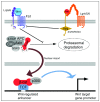Wnt target genes and where to find them
- PMID: 28649368
- PMCID: PMC5464219
- DOI: 10.12688/f1000research.11034.1
Wnt target genes and where to find them
Abstract
Wnt/β-catenin signaling is highly conserved throughout metazoans, is required for numerous essential events in development, and serves as a stem cell niche signal in many contexts. Misregulation of the pathway is linked to several human pathologies, most notably cancer. Wnt stimulation results in stabilization and nuclear import of β-catenin, which then acts as a transcriptional co-activator. Transcription factors of the T-cell family (TCF) are the best-characterized nuclear binding partners of β-catenin and mediators of Wnt gene regulation. This review provides an update on what is known about the transcriptional activation of Wnt target genes, highlighting recent work that modifies the conventional model. Wnt/β-catenin signaling regulates genes in a highly context-dependent manner, and the role of other signaling pathways and TCF co-factors in this process will be discussed. Understanding Wnt gene regulation has served to elucidate many biological roles of the pathway, and we will use examples from stem cell biology, metabolism, and evolution to illustrate some of the rich Wnt biology that has been uncovered.
Keywords: T-cell factor; Wnt; beta-catenin; gene regulation; target location.
Conflict of interest statement
Competing interests: The authors declare that they have no competing interests.No competing interests were disclosed.No competing interests were disclosed.No competing interests were disclosed.
Figures

References
Publication types
Grants and funding
LinkOut - more resources
Full Text Sources
Other Literature Sources
Molecular Biology Databases

